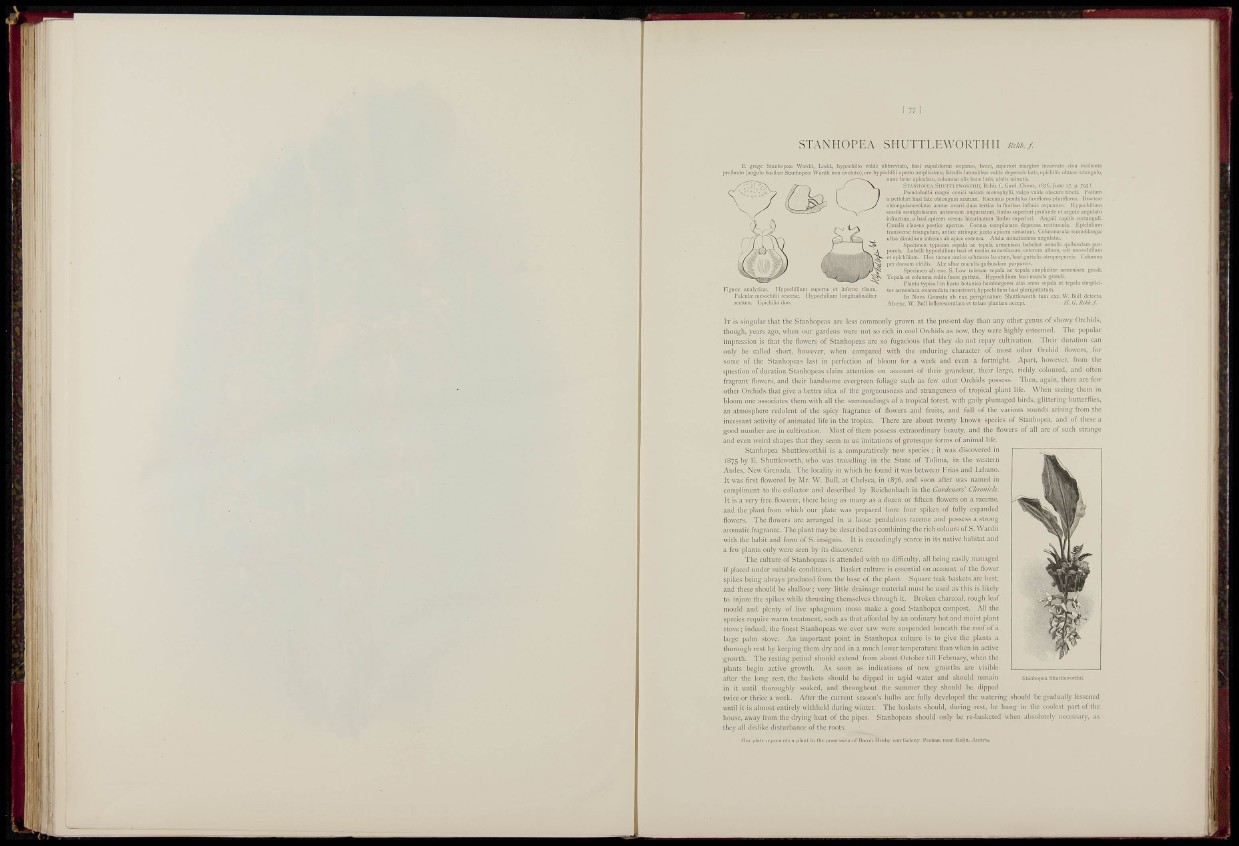
, il
l i i !
l i n i
STANHOPEA SHUTTLEWORTH11 KM./.
STANIIOI'EA 5
15 lalcrralibus valili- depressi! lalia, cpichillo c
aUsbcnclali», alul!» minuti^.
WOKTIMI, Udib. Ì, Gard. Cliron., 1876, Jimi
a pcllolnri basi lulc oblong^im Mutuin.
scssik scniiglobosuin antrorsurii angu:
infraclum, a basi ai>i«m versus bicari:
Canali« claosiis postici: apcrtus. Con
ultra liimidiuin inferius ab apio
S))cdmcii lypicum scp:
Ijurcjs. Label!i Kypochiliutn bi
et cpicliilitim. Hoc is
jwr dorsum vlridis. AIx alba: ni
Spocimcn ab cxc. S, Low missi
Tcpnla c-t collimila vatclu fucrt: gulUla.
Pianta tj'pica I in liorto botanicc
iccnius pcnilulua bxillonis plurirtunis. I
riori profutidc ci argulc angulalo
IO superiori. An);uli capitis rccianguli,
. Kpichilium
lu idn: seiniublongaibusdain
purjiurcis.
I scpal.i ac lc|)ala simplicitcr amicnlaca gcssit.
i-ly podi ilium basi inacula grandi.
p scpala et topaia simpliciit,
tiypocliilium basi ptiiriRi
Abexc. W. Bull inflorcsccnciam ct'lotam plan tarn accepi. 1!. C. KM.f.
IT is singular that the Stanhope.is are less commonly grown at the present day than any other genus of showy Orchids,
though, years ago, >vhen our gardens ^vere not so rich in cool Orchids as now, they were highly esteemed. The |)opuIar
impression is that the flowei's of Stanhopeas are so fugacious that they do not repay cultivation. Their duration can
only be called short, however, when compared with the enduring character of mosl other Orchid Howers, for
some of the Stanhopeas last in perfection of bloom for a week and even a fortnight. Ai»rt, however, from the
question of duration Stanhopeas claim attention on account of their grandeur, their large, richly coloured, and often
fragrant flowers, and their handsome evergreen foliage such as few other Orchids possess. Then, again, there arc few
other Orchids that give a bettei idea of the gorgcousness and strangeness of tropical plant life. When seeing them in
bloom one associates them with all the surroundings of a tropical forest, with gaily plumaged birds, glittering butlorfiies,
an atmosphere redolent of the spicy fragrance of flowers and fruits, and full of the various sounds arising from the
incessant activity of animated life in the tropics. There are about twenty known species of Stanhopea, and of these a
good number are in cultivation. Most of them possess extraordinary beauty, and the flowers of all arc of such strange
and even weird shapes that they seem to us imitations of grotesque forms of animal life.
Stanhopea Shuttlcuorthii is a comparatively new species ; it was discovered in
1875 by E. Shuttleworth, who was travelling in the State of Tolima, in the western
Andes, New Grenada. The locality in which he found it was between Frias and Lebano.
I t was first flowered by Mr. W. Bull, at Chelsea, in 1876, and .soon after was named in
compliment to the collector and described by Reichenbacli in the Gardeners' Clnoinclc.
It is a very free flowerer, there being as many as a dozen or fifteen flowers on a raceme,
and the plant from which our plate was prepared "bore four spikes of fully ex|3anded
flowers. The flowers are arranged in a loose pendulous raceme and possess a strong
aromatic fragrance. The plant may be described as combining the rich colours of S. Wardii
with the habit and form of S. insignis. It is exceedingly scarce in its native habitat and
a fe^v ¡)lants only were seen by its discoverer.
The culture of Stanhopeas is attended with no difliculty, all being easily managed
if placed under suit;ible conditions. Basket culture is essential on account of the flower
spikes being always produced from the base of the plant. Sciuare teak baskets are best,
and these should be shallow; very little drainage material must be used as this is likely
to injure the spikes while thrusting themselves through it. Broken charcoal, rough leaf
mould and plenty of live sphagnum moss make a good Stanhopea com])ost. All the
species require warm treatment, such as that afforded by an ordinary hot and moist plant
stove; indeed, the finest Stanhopeas we ever saw were suspende<l beneath Ihc roof of a
lai^ge palm stove. An im|)ortant point in Stanhopea culture is to give the plants a
thorough rest by keeping them dry and in a much lower temperature than when in active
growth. The resting period should extend from about October till February, when the
plants begin active growth. As soon as indications of new growths are visible
after the long rest, the baskets should be dipped in tepid water and should remain
in it until thoroughly soaked, and throughout the summer they should be dipped
twicc or thrice a week. After the currcnt season's bulbs are fully developed the watering shouki be gradually lessened
until it is almost entirely withheld during winter. The baskets shouki, during rest, be hung in the coolcst part of the
house, away from the drying heat of the pipes. Stanho|x:as shouki only be re-basketed \vhen absolutely necessary, as
they all dislike disturbance of the roots.
Our pl.itc reprcscnis a jilant in the possession of Baron Unib)'von Gcleny, I'cckau, nc.ir Kolin, Austria.
Stanhopcii